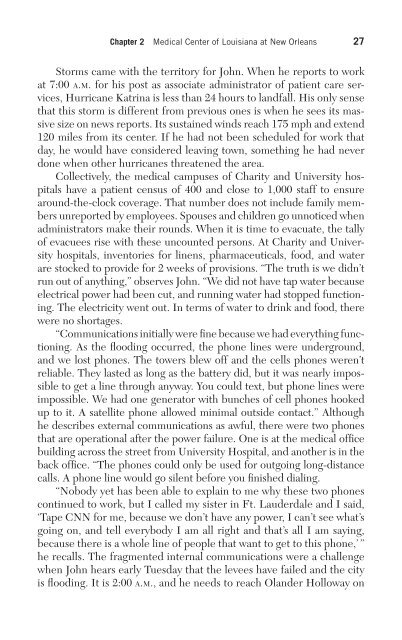Nursing in the Storm - Springer Publishing
Nursing in the Storm - Springer Publishing
Nursing in the Storm - Springer Publishing
Create successful ePaper yourself
Turn your PDF publications into a flip-book with our unique Google optimized e-Paper software.
6 <strong>Nurs<strong>in</strong>g</strong> <strong>in</strong> <strong>the</strong> <strong>Storm</strong>: Voices from Hurricane Katr<strong>in</strong>a<br />
The fourth hospital, built dur<strong>in</strong>g <strong>the</strong> follow<strong>in</strong>g 5 years after that fire,<br />
was relocated to Canal Street, <strong>the</strong>n actually swampland that sat next to<br />
<strong>the</strong> cemeteries. This hospital was considered a very large facility <strong>the</strong>n,<br />
provid<strong>in</strong>g care for 120 patients, but after several years, it was found to<br />
have deplorable conditions (Salvaggio, 1992).<br />
Due to <strong>the</strong> enormous <strong>in</strong>crease <strong>in</strong> <strong>the</strong> city’s population, a fifth Charity<br />
Hospital was built <strong>in</strong> 1833. This fifth hospital—because of its size, physical<br />
structure, and number of beds—was considered a city landmark (Salvaggio,<br />
1992). The sixth and current Charity Hospital was built <strong>in</strong> 1939<br />
at its present site on Tulane Avenue after a personal visit from President<br />
Theodore Roosevelt. The new Charity Hospital opened with 2,650 beds,<br />
along with a 14-floor school of nurs<strong>in</strong>g. It was <strong>the</strong> second oldest hospital<br />
<strong>in</strong> <strong>the</strong> country at <strong>the</strong> time, and <strong>the</strong> oldest cont<strong>in</strong>uously operat<strong>in</strong>g hospital<br />
bear<strong>in</strong>g <strong>the</strong> same name <strong>in</strong> <strong>the</strong> United States (Salvaggio, 1992).<br />
Car<strong>in</strong>g for <strong>the</strong> <strong>in</strong>digent, whe<strong>the</strong>r native born or European immigrants,<br />
and respond<strong>in</strong>g to <strong>the</strong> needs of <strong>the</strong> public has been <strong>the</strong> mission<br />
of Charity Hospital s<strong>in</strong>ce its found<strong>in</strong>g. Over <strong>the</strong> years, Charity Hospital<br />
had faced l<strong>in</strong>ger<strong>in</strong>g f<strong>in</strong>ancial pressures, political favoritism, problems<br />
with poor staff<strong>in</strong>g, overcrowd<strong>in</strong>g, an unsanitary environment, and poor<br />
or nonexistent equipment and supplies. Be<strong>in</strong>g governed by many authorities,<br />
<strong>in</strong>clud<strong>in</strong>g <strong>the</strong> Daughters of Charity and <strong>the</strong> state, also placed<br />
pressures on <strong>the</strong> hospital, compromis<strong>in</strong>g its work for <strong>the</strong> community that<br />
it served.<br />
University Hospital was opened as Hotel Dieu Hospital <strong>in</strong> 1859,<br />
over 100 years after Charity Hospital. It was founded, owned, and operated<br />
by <strong>the</strong> Daughters of Charity, an American order of nuns affiliated<br />
with Elizabeth Ann Bayley Seton of France. The name Hotel Dieu<br />
means “House of God” <strong>in</strong> French. Hotel Dieu kept its doors open and<br />
operational dur<strong>in</strong>g <strong>the</strong> Civil War and through two yellow fever epidemics<br />
(University Hospital, 1996–2007).<br />
A new Hotel Dieu Hospital was built <strong>in</strong> 1924 and, <strong>in</strong> 1972, was replaced<br />
with ano<strong>the</strong>r new build<strong>in</strong>g, still located on Perdido Street <strong>in</strong> New<br />
Orleans. In 1992, Louisiana governor Edw<strong>in</strong> Edwards requested that<br />
<strong>the</strong> Daughters of Charity sell Hotel Dieu to <strong>the</strong> state. At that time, Hotel<br />
Dieu Hospital was renamed University Hospital (University Hospital,<br />
1996–2007).<br />
The Medical Center of Louisiana at New Orleans (MCLNO; both<br />
Charity and University hospitals) suffered major destruction due to Hurricane<br />
Katr<strong>in</strong>a <strong>in</strong> August 2005. Both campuses were closed after Katr<strong>in</strong>a,<br />
which resulted <strong>in</strong> a major loss <strong>in</strong> health care services for <strong>the</strong> underserved

















